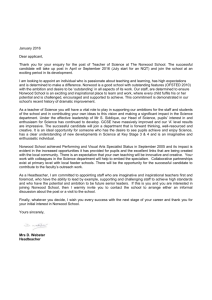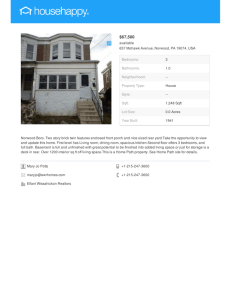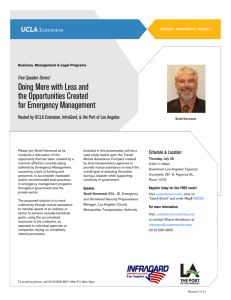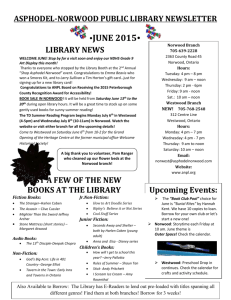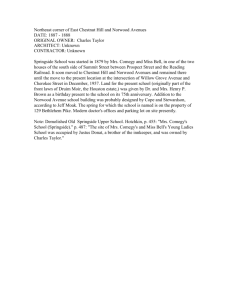History Narrative
advertisement
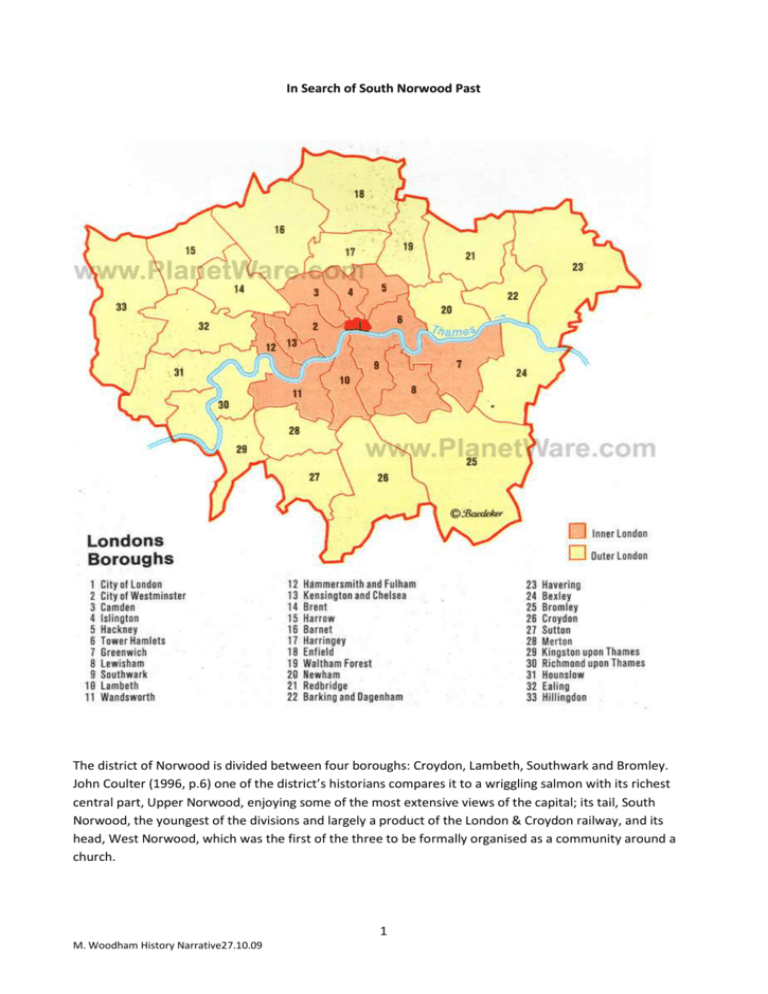
In Search of South Norwood Past The district of Norwood is divided between four boroughs: Croydon, Lambeth, Southwark and Bromley. John Coulter (1996, p.6) one of the district’s historians compares it to a wriggling salmon with its richest central part, Upper Norwood, enjoying some of the most extensive views of the capital; its tail, South Norwood, the youngest of the divisions and largely a product of the London & Croydon railway, and its head, West Norwood, which was the first of the three to be formally organised as a community around a church. 1 M. Woodham History Narrative27.10.09 When I set off on my exploratory walk around the Polish school and chapel in South Norwood, I feel like a child just starting her Easter egg hunt. I have read about South Norwood’s colourful past and now I want to imagine myself walking into that old world and finding all its architectural landmarks. I also want to mingle into the crowd of Victorians as I know that South Norwood scarcely existed as a community before 1839 when the first railway station was established. It is a sunny and exceptionally warm day on October 27th and I approach the town centre from the north, up Portland Road. Before I started researching the area it was just Portland Road to me, like any other road in the borough. Now knowing the history of it, it became the Portland Road named in the 19th century after the 4th Duke of Portland (1768-1854), a cabinet minister who lived in Upper Norwood, in a large villa with extensive grounds from 1839 to 1847. Before the High Street was created as a shopping centre in 1860s Portland Road was where the first shops had appeared. Now I could see many Victorian buildings unchanged. Although South Norwood suffered heavy damage during World War II, Portland Road and the High Street remained unscathed. 2 M. Woodham History Narrative27.10.09 If I had followed the same route in Victorian times, I might have just been able to see the glass rooftops of Crystal Palace glistening in the sun ahead of me in the distance. How lovely it would have been to have had at my doorstep this impressive glass building surrounded by 300 acres of grounds with a whole network of lakes and fountains surpassing Versaille. I could have gone there to the library, for lectures, exhibitions, concerts and walks. Crystal Palace was designed by Joseph Paxton and built originally in Hyde Park for the Great Exhibition of 1851. It took up to 5000 labourers nearly 2 years to rebuild the Palace on the hill between Norwood and Sydenham. It was opened to the public by Queen Victoria on 10th June 1854. The new Crystal Palace had dominant influence on the area in its first 15 years. At that time, new shops, churches and hotels were built and the whole area flourished. To the horror of people witnessing it (the noise was heard for miles around) in 1936 a fire totally destroyed the already declining Crystal Palace. To get to the Polish school I drive under a bridge above Portland Road. I am aware that by crossing the railway track I am crossing the Victorian boundary between an area of poverty and an area of moderate wealth. Oliver Grove, where the Polish school and church are located, together with other roads nearby, was part of a private estate built between 1860 and 1870 in an attempt to create a middle class South Norwood which would be the continuation of Upper Norwood. After I’ve parked the car I walk slowly towards Oliver Grove. I now need to have a careful look at those Victorian middle-class houses, especially the two now owned by the Polish parish. 3 M. Woodham History Narrative27.10.09 The house at 8 Oliver Grove and its plot of land was bought by the parish from its British owner in 1983 and now houses two parish priests . Undeterred by the presence of the Reverend’s Honda Civic parked at the front of the house, I picture a smart Victorian couple leaving the house, getting into a horse driven carriage and disappearing into the distance. 4 M. Woodham History Narrative27.10.09 Next to the parish house at 8 Oliver Grove is a house at 6 Oliver Grove. It used to be owned by Mr and Mrs Brzeski, one of the very first three hundred Polish families settling in the area after World War II. Mr and Mrs Brzeski were one of the founders of the school and the church and their devoted supporters. The couple donated the house to the parish and in 1950 the Polish Croydon-Crystal Palace Polish School was set up. This academic year the school will be celebrating its 6oth anniversary. The entrance to the school is on the right, at the extended part to the rear. The hall built in 1966 is part of the extension and adjoins the chapel, which was built in 1985. When I open the school door I have a feeling that I enter a living organism: the church is on my left, the school is on my right and in the middle is the hall where all the aspects, religious, social and cultural, come together. 5 M. Woodham History Narrative27.10.09 The feeling of entering a living organism is compouded when I enter the hall. “Krasnoludki”, the mother and toddler group, have their morning session in there. Tens of very young children jump, skip and run around with abandon playing with colourful toys. About twenty five parents (mainly mums, but I can see two fathers , too) drink tea and coffee sit or stand in small groups talking. I stop to chat to Agnieszka, one of the mums organising the group. I take some notes and after half an hour I set off again on my history quest. Ornamental columns and sculptures in front of some of the houses reveal the elegance and fashionable character of Oliver Grove in the second half of the 19th century. Since then these big houses became too expensive and were turned into flats. 6 M. Woodham History Narrative27.10.09 I come out of the quiet residential Oliver Grove towards the roaring flow of cars and pedestrians in the High Street. Judging from the original photographs the High Street was as busy in the second half of the 19th century as it is now. In the middle of it steam and later electric trams rumbled along and on the pavements pedestrians did their shopping at the chemist’s, the bucher’s, the tailor’s, the goldsmith’s, the bookseller’s, at the dairy, the brick and tile manufacturer’s, at the toyshop, the confectioner’s or the builder’s and house decorator’s. From the tranquility of Oliver Grove I walk towards the clocktower. And again it is the Clocktower to me now, the one erected in 1907 by the South Noorwood community to commemorate the golden wedding anniversary of William Ford Robinson Stanley, the greatest of Norwood industrialists and benefactors. 7 M. Woodham History Narrative27.10.09 Stanley took an active part in the life of the community and presented it with the gift of Stanley Halls in 1903 and Stanley Technical Trade School in 1907 whose aim was to provide a general and trade education to boys aged 12 to 15. It was one of the first technical trade schools in the country and is now Stanley Technical High School. 8 M. Woodham History Narrative27.10.09 It used to be an unremarkable High Street to me when I hurried along to the Polish shop called Polish Express to buy food I could not get in the English shops such as herring or buck wheet . Now, when I walk slowly and notice its important hisorical landmarks, it becomes significant. 9 M. Woodham History Narrative27.10.09 In the first half of the 19th century The Jolly Sailor pub was bursting with life with its large tea gardens full of customers coming from London to have fun in the fresh air of the countryside. When the first railway station in the area was established in 1839 it was called the Jolly Sailor Station due to its proximity to the pub. The Jolly Sailor’s large tea gardens ran down to the canal, a source of delight to the inhabitants as they could ride in boats, fish, bathe or stroll along its banks. I notice how quiet and peaceful the place is, well below the level of the busy High Street. Now I can picture the charming scenes as I walk on the tarmacked surface of the car park covering that ground. 10 M. Woodham History Narrative27.10.09 The Croydon Canal was opened in 1809 as a means of communication between Croydon and London. Its purpose was to bring coal and general merchandise to Croydon and return with agricultural produce, lime, chalk, flint and timber. At that time Croydon had a population of 7,000 and Norwood was just a village in the woods . With the development of the railway this was about to change. In 1836 The London and Croydon Railway bought the canal which was drained of water and its bed was covered with rail tracks ready for steam trains. The first train station was built and named The Jolly Sailor as it was close to the tavern. in 1859 it was replaced by the larger Norwood Junction to serve a growing number of business and professional men commuting to the City. From the station I walk towards Tennyson Road where Sir Arthur Conan Doyle lived from 1891 to 1894. There are not many Victorian houses in this road as they were not always in fashion in the 20th Century. Many were demolished, especially in the 1960s and replaced by modern town houses. 11 M. Woodham History Narrative27.10.09 As I walk back towards the car I notice more splendid Victorian houses with their charming ornamental details like this one in Warminster Road. Eventually I get to the South Norwood Lake which is now the only remnant of the Canal and used to be its reservoir. 12 M. Woodham History Narrative27.10.09 By the lake, among its green surroundings, I try to imagine walking through primeval North Wood, which covered the whole area of the north of Croydon centuries ago and from which Norwood takes its name. The North Wood (and the South Wood to the south of Croydon) contained mainly coppice trees used for fencing and broom-making but also ancient oak trees which provided the North Wood’s owners, the Archbishops of Canterbury, with timber for sale. Another source of income for the Archbishops was the sale of charcoal which was burnt and sold as luxury fuel to the households of London. If it was summertime sometime in the 1700s I might have met some famous gypsy fortune tellers in Norwood. They were very popular with London day trippers but feared and distrusted in the villages. By the end of the 19th century, gypsies melted into the population of Norwood or moved their caravans further away. As I drive home, I see Norwood’s history as a series of pictures unfolding in my head like a film reel: the enormous, dark North Wood with cottages on its outskirts, the bucolic countryside for the London nobility, the fashionable, tranquil suburb for rich Londoners, the tightly built-up suburb for the London commuters and now a multicultural area of South London where the old mixes with the new. Bibliography Coulter, J. (1996) Norwood Past, Historical Publications, London Warwick, A. R. (1991) The Phoenix Suburb, Second Edition, The Norwood Society, London Reed, n. J. (1995) Crystal Palace and the Norwoods, Chalford, Stroud, Gloucestershire Local Studies Pack, 2nd Edition (May 1995) South and Upper Norwood, Croydon Libraries 13 M. Woodham History Narrative27.10.09
